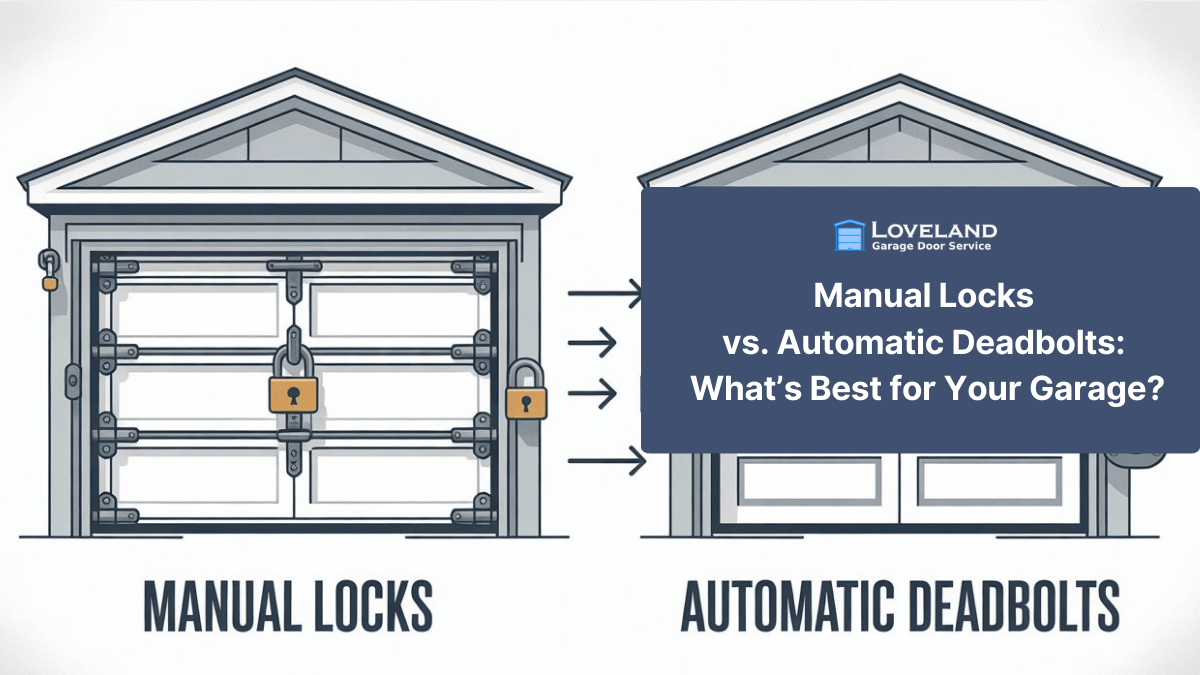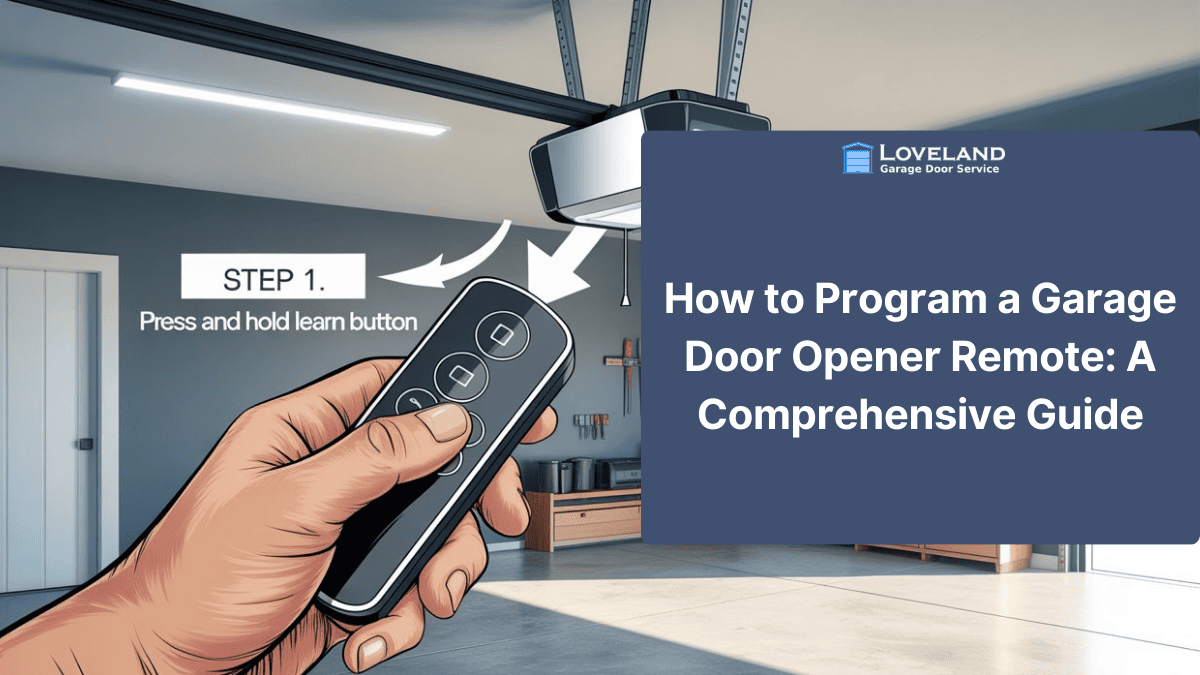When we think about home security, we often picture deadbolts on the front door, motion sensor lights, or alarm systems. However, for many homeowners in Northern Colorado, the primary entrance to the house isn’t the front door—it’s the garage.
While garage doors are convenient, the opener that powers them can be a surprising weak link in your home’s defense if it is outdated. Garage door openers manufactured before 2011 (and especially those from the 1990s) lack the sophisticated encryption and mechanical locking features standard in today’s models.
At Loveland Garage Door Service, we want to ensure your home is as safe as it is functional. Here are three hidden security risks lurking in older garage door openers and the modern solutions available to fix them.
The Traditional Choice: Manual Garage Door Locks
If you look at the inside of your garage door, near the rollers on the side track, you might see a metal bar or a sliding latch. This is the manual lock (often called a slide lock or side lock). It is a simple mechanical device that slides a metal bar through a hole in the vertical track, physically preventing the door from moving upward.
The Pros of Manual Locks:
- Simplicity and Durability: There are no electronics to fail, no batteries to replace, and no software to update. It is a solid piece of metal. If you are using your garage strictly for long-term storage and rarely open the door, this is a cost-effective solution.
- Vacation Security: Manual locks are excellent for “vacation mode.” If you are leaving Loveland for a week-long trip, engaging the manual lock ensures that even if someone hacks your opener signal, the door physically cannot open.
- Cost: Manual locks are inexpensive to install and replace.
The Cons of Manual Locks:
- The “Human Error” Risk: This is the single biggest downside. If you engage the manual lock and then someone else in the family (who doesn’t know it’s locked) tries to open the door with the remote, catastrophe strikes. The motor will try to lift the door, but the lock will hold it down. The result? Ripped metal, stripped gears, a burned-out motor, or a door pulled off its tracks. It is one of the most common repair calls we receive.
- Inconvenience: You cannot lock or unlock it from your car. You must be inside the garage to engage it. This means it rarely gets used for daily protection, leaving your home vulnerable on a typical Tuesday night.
- No Remote Monitoring: You cannot check if a manual lock is engaged from your phone.
The Modern Solution: Automatic Garage Door Deadbolts
Automatic garage door deadbolts (often referred to as “Power Locks”) represent the next generation of security. These are electronic deadbolts that wire directly into your garage door opener. When you press your remote to close the door, the opener lowers the door, and once it is fully closed, the deadbolt automatically slides into the track with a reassuring click. When you press the remote to open it, the bolt retracts before the door begins to move.
The Pros of Automatic Deadbolts:
- Foolproof Operation: Because the lock is controlled by the opener itself, the system knows exactly when to lock and unlock. You will never accidentally destroy your door by trying to open it while locked. The opener retracts the bolt before lifting the door, eliminating the risk of damage.
- Everyday Security: unlike manual locks, which are only used occasionally, automatic deadbolts secure your home every single time the door closes. You don’t have to think about it.
- Defeating the “Coat Hanger” Trick: A common burglary method involves sliding a wire hook through the top of the garage door to pull the emergency release cord. This disconnects the door from the opener, allowing the thief to lift it by hand. An automatic deadbolt physically locks the door to the track. Even if the emergency cord is pulled, the door remains locked down.
- Weather Sealing: By physically pushing against the track or locking the door in the down position, these locks can help hold the door tighter against the floor, which is helpful during Loveland’s windy seasons.
The Cons of Automatic Deadbolts:
- Cost: These systems are more expensive than manual latches and usually require a compatible opener model (such as the LiftMaster 8500W wall-mount series).
- Installation Complexity: These require professional installation to ensure the wiring is correct and the lock aligns perfectly with the track holes.
Which Is Right for Your Loveland Home?
To decide between the two, you need to evaluate how you use your garage.
Scenario A: The “Front Door” User You park in the garage every day. You use the keypad to let the kids in after school. You want seamless convenience. Verdict: Automatic Deadbolt. Manual locks are simply too cumbersome for daily use. An automatic deadbolt gives you the heavy-duty security of a physical lock without the hassle. It offers peace of mind that your door is deadbolted every night without you lifting a finger.
Scenario B: The “Storage Unit” User You park in the driveway. The garage is full of boxes, tools, or a classic car that only goes out on Sundays. You rarely open the big door. Verdict: Manual Lock. Since you aren’t opening the door frequently, the risk of accidental damage is low. You can keep the slide lock engaged permanently for maximum security and simply disengage it on the rare occasions you need to open the door.
Scenario C: The Tech Enthusiast You have a smart home with cameras and automated lights. Verdict: Automatic Deadbolt. Modern power locks integrate with smart home apps (like myQ). You can receive an alert on your phone not just that the door is closed, but that it is locked.
A Note on the "Lock" Button on Your Wall Console
Many homeowners confuse the physical manual lock with the “Lock” button found on their wall-mounted control panel.
- The Wall Console “Lock” (Electronic Lock): This button stops the opener from accepting signals from remote controls. It is great for vacationing, but it does not physically lock the door to the track. A burglar could still manually lift the door if they managed to trigger the emergency release.
- The Physical Lock: This (whether manual or automatic) physically secures the door to the metal track.
For maximum security, we recommend a combination: use an automatic deadbolt for physical resistance and the wall console lock for electronic signal blocking when you are away on vacation.
Conclusion
Your garage door is a massive investment and a critical part of your home’s security envelope. While manual locks have served us well for decades, the convenience and safety features of automatic deadbolts make them the superior choice for most modern households in Loveland. They remove the human error that leads to costly repairs and ensure your home is secure 24/7, not just when you remember to slide a latch.
If you are unsure which system is currently on your door, or if you are interested in upgrading to an opener that supports automatic power locks, Loveland Garage Door Service is here to help or you can Call Us Today (970) 367-8600
We can assess your current setup, explain your options, and provide professional installation to ensure your home remains safe and secure against both intruders and the Colorado elements.





